Unlocking secrets hidden deep inside the trees of Oregon’s Blue Mountains
I was instructed to aim the borer at the tree collar, where the roots met the trunk. This was after cleaning house—brushing away debris to have full range of motion and a comfortable enough place to kneel. I pressed the threaded steel bit into a furrow in the bark, leaned slightly forward, and started to turn.
Soft knocking sounds as the bit sunk were replaced by loud ratchety whines as it hit resistance. Yinko, a German Shepard-Lab mix who served as our companion, began to howl. After the dog was calmed, I continued to turn.
My coring teacher and project manager was Laura Platt, a geography graduate student who before this project monitored spotted owls on the Olympic Peninsula. A northern flicker feather hung from the end of her long brown braid. A barbell ran through her eyebrow under a trucker hat displaying an outline of mountains, and her canvas pants were stitched in spots. When I met her a week earlier to discuss the project, her fingers were taped—she was in the middle of a tree climbing class, a pedagogy I was happy to hear existed.
The shaft sank deeper as I turned the handle. The sound was something like a rooster being strangled. It needed to go deep enough to reach the pith, the central dot the rings grew around.
She emphasized caution when using the expensive Swedish-made tree corers. One of the more delicate pieces of the three-part tool was the straw, a sort of dipstick with a toothed end that slipped into the auger shaft to retrieve the sample. Another fragile part was the bit at the top the shaft; the Teflon-coated steel chipped if clumsily handled. It resembled a screw, but instead of a pointy tip it had a small mouth that carved a wood tube a little thinner than the circumference of a Bic pen. This was our sample, encircled by tree rings.
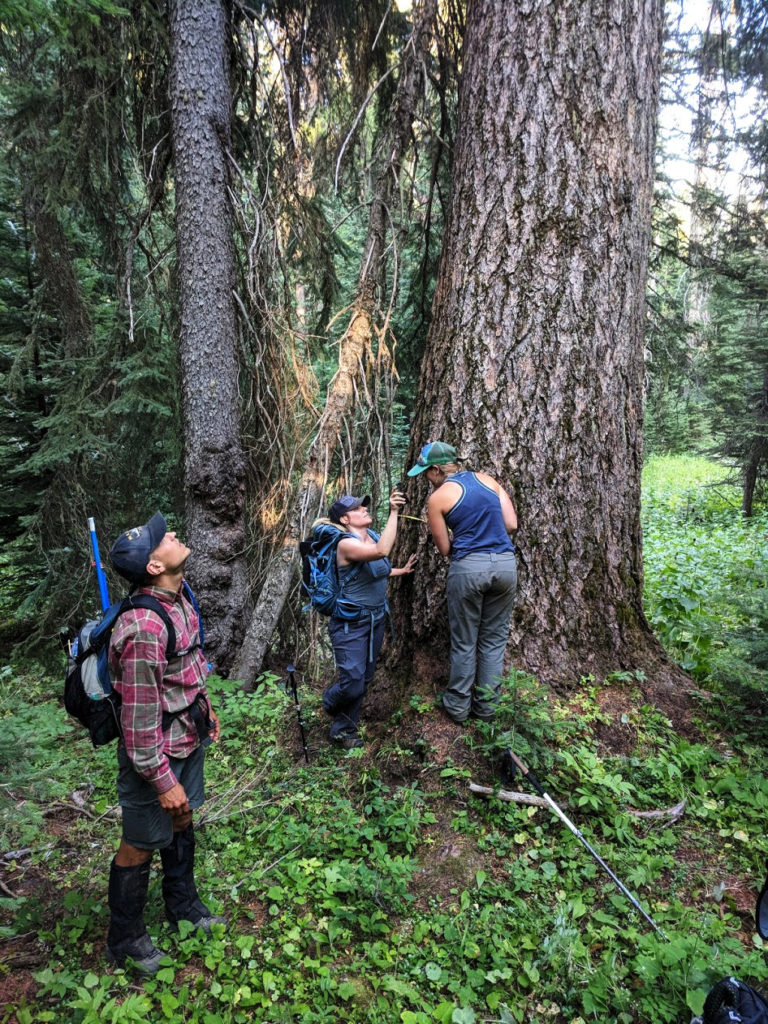
Sometimes the rings were well-spaced helixes, and at other times scrunched into almost indiscernible swirls. Good samples were bagged and tagged, placed into perforated plastic straws marked with masking tape. Getting a good sample in this mixed, moist conifer forest at roughly 5,000 feet could take numerous pokes due to the abundance of rot.
The shaft sank deeper as I turned the handle. The sound was something like a rooster being strangled. It needed to go deep enough to reach the pith, the central dot the rings grew around. “Getting pith” was striking gold. It meant one got to stand up and announce the next number in the sequence, like calling bingo.
The moment of truth had come. My first tree, a western larch, would either cough up a clean or rotten sample. I stuck the dipstick into the shaft. As suggested, I broke the end of sample off by turning the handle backwards a couple of cranks. I slowly pulled the dipstick out. What emerged was a nub of bark, dark and intact; then came the lighter sapwood, heartwood, and…
I called out to Laura.
She came over and eyed the sample. “You’ve got pith!”
I held the straw and the time tube resting in its concave bed in my upturned hands, my first true scientific offering. After bagging it, I returned to my tree. Reversing the borer the rest of the way conjured a subdued whimper, sounding like eerily human “oohs.”
I was the fifth member of a four-woman crew collecting tree and plant data in the Blue Mountains of northeast Oregon for a collaborative study that included the Nature Conservancy, the Oregon Department of Forestry, and Portland State University. Laura was studying under Andres Holz, who runs Portland State’s global environmental change lab. Holz’s work has focused on the relationships between climate change, humans, and fire. The on-the-ground samples we were acquiring were part of a year-long project to understand how these forest worked before we began changing them.
Laura’s plots were constructed from aerial photos taken in the 1930s; the photos had been taken by the Forest Service to catalog tree types for the timber industry. Broad goals for her data included reconstructing the frequency and severity of past fire activity and studying how the forest regenerated after fires. Laura could go back through the tree rings to well before the 30s, when scientists suspect fires in the Blue Mountains occurred regularly but with low severity. She might then be able to see how suppressing fires—which ramped up around the time the photos were taken—had altered the ecology of the land.
Holz explained to me that “we need more context” about the land and its history in an area this complex. As the Pleistocene ended, humans arrived in the inner Northwest, around 11-13,000 BP. Natives purposefully burned the land at lower elevations to enhance food production and improve grazing conditions for deer, elk, and bear. We do not have historical narratives to determine to what extent their burning altered the land. But we do begin to see the larger scale alterations with the arrival of Europeans to the region, initially due to sheep and cattle grazing beginning in the 1850s.
A series of federal laws (1845-1875) encouraging the US army to eradicate native American tribes throughout the west likely added to the reduction of burning. Tribes that weren’t decimated were indoctrinated by custom and religion. Protestant missionaries weren’t only intent on saving souls, notes forest ecologist Paul Hessburg in his fascinating history of the region, An Environmental Narrative of Inland Northwest United States Forests, they were also keen on reducing the native subsistence lifestyle. He quoted one missionary’s writing: “while we point them with one hand to the Lamb of God which taketh away the sins of the world, we believe it to be equally our duty to point with the other to the hoe.”
In the years between 1800 and 2000, Hessburg writes, “the region has undergone fur trapping and trading, sheep, cattle, and horse grazing, timber harvesting, mining, road construction, native grassland conversion to agricultural production, urban and rural development, fire prevention, and fire suppression.” And now we can add human-induced climate change to the list.
Tree ring chronologies can take us back into those centuries. Their data could parallel and prove aspects of the Hessburg story, giving land managers and the public clearer science to support or dissuade a given treatment plan. Though it was rare to have large fires at that elevation, the term rare itself is losing its bite these days. We are seeing longer, hotter fire seasons. We’re seeing less snowpack. We’re seeing fuel loads build up in the understory.
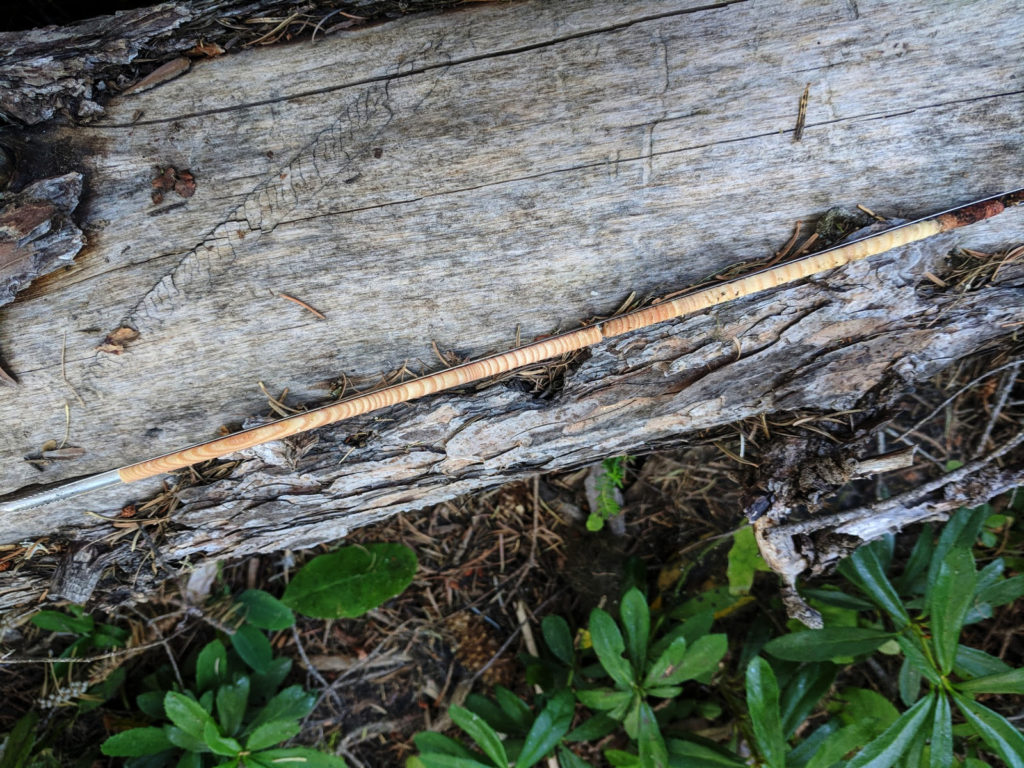
Because of fire restrictions, the crew was unable to take fire scar samples, a way to date when a blaze occurred by cutting a sample out with a chainsaw. They photographed and took coordinates of scars to return to later. Their contribution to the Umatilla forest puzzle this time around would be through coring, vegetation surveys, and removing a few saplings. Similar studies have been conducted in drier forests in the Blue Mountains, where ponderosa pines and lodgepole pines are more abundant. But not up where we worked; this is a denser, more fire-intolerant zone.
We were supposed to stay at the Jubilee Lake Campground. It was jarring to return to the 40-site car campground after spending hours deep in the woods, where aside from our coring and chit chatting, sounds alternated between trees swishing and knocking in the wind, birds twittering, and insects humming. One of our neighboring campers cut wood with a circular saw while another ran a generator clear through the night.
The next morning before we left Jubilee, Jen—one of our crew members who grew up off the grid (her nearest year-round neighbor was five miles away)—went to talk to the generator runners. Their truck was wrapped in decals advertising their big game hunting outfit.
“How’d it go?” I asked when she returned.
“Not so good.”
She said she’d spoken with a woman. Jen informed her of the campground’s 10 pm quiet time. Another woman peered over the woman’s shoulder, a ceiling fan spinning above their heads.
“If you don’t get off my site, my husband is going to fuck your shit up,” she told Jen.
One of our crew had been threatened with violence from a family of big game hunters in a semi-lawless place with minimal phone reception. We went to the camp host site, but it was occupied by regular campers. That evening we drove up an old Forest Service road and found a beautiful single campsite shaded by huge grand firs. Without deliberation, we moved camp.
I was handed a bark chip and asked if I could smell the vanilla. It smelled as if I was holding a bowl of ice cream. Laura’s description of the smell of a spruce sample was a “thunderstorm mixed with the garden section at Walmart.”
The pathless trounces between plots—crossing down into and up out of drainages, stepping on fallen branches, and crawling under logs—put considerable real and metaphorical distance between us and the human world. Bushwhacking was often when I would chat with Katya. Earlier in her life she’d been on a wildland firefighting crew that tracked pieces of the Columbia space shuttle that exploded upon re-entering the atmosphere. She was one of a 25,000 person effort that searched 2.5 million acres in Texas. They found everything from twelve-foot sections of wing to tiny pieces of machinery to intact body parts. They were instructed not to use their radios if coming upon a blasting cap—something in the explosive cap was magnetic and could be pulled to the radio. In the end, NASA was able to recover between 30-40 percent of the shuttle.
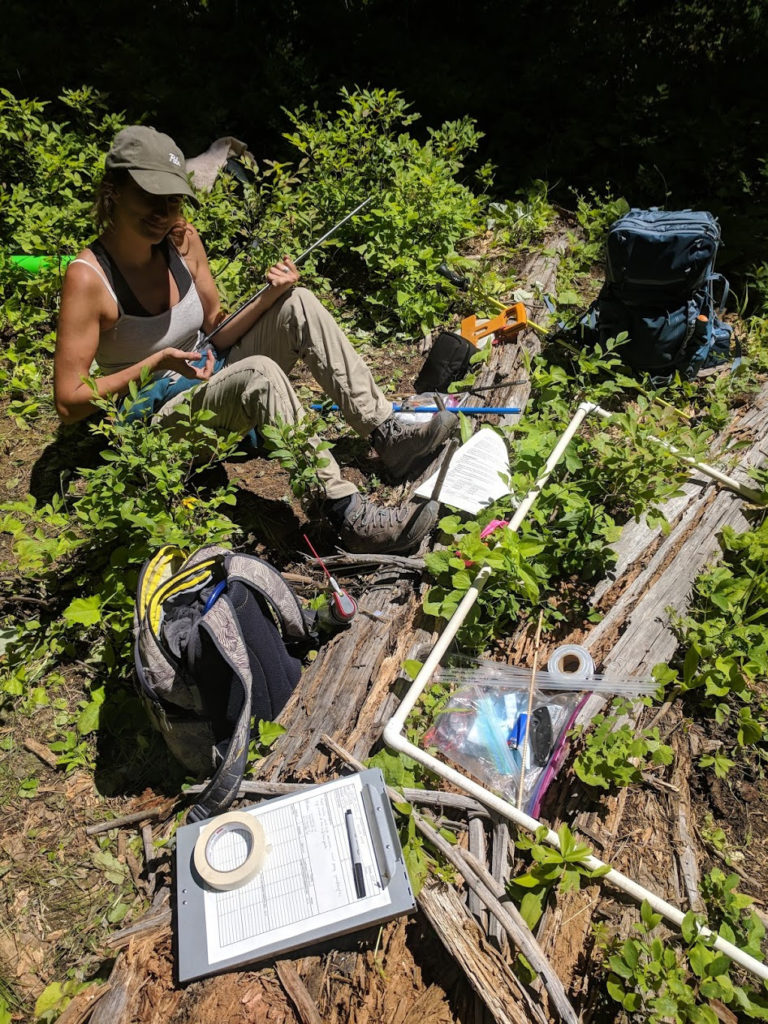
Katya trains powerlifters when she’s not coring and botanizing. She had great stories and a wealth of ready information about flora. That plant with the sticky little corn cob end was a pinedrop. The mushroom shelves studding that grand fir were the tips of the iceberg, the fruiting bodies that had traveled up through the sap and water networks of what was most likely a rotted tree. Before we began coring she surveyed a site by eye: meadow rue, foamflower, ocean spray, bracken fern, queen’s cup, soapberry, twinflower, lupine, thermopsis, larkspur, pathfinder (whose soft fuzzy underside was pleasant to touch), huckleberry, twinberry, galium, and linnaea. Gramanoids—or grasses and sedges, she explained—were harder to identify. Like asters, gramanoids had their own set of anatomical terminology. She carried a trowel to dig up some of these trickier ones; the roots helped the identification process. At night she and Laura put on headlamps and plopped the plucked plants onto a picnic table to sort them out.
The other two crew members were newer to fieldwork. Jen had been considering graduate school and was looking to get field experience. She had had an option to work at a winery this summer, but chose this instead.
“My friends all work in business or finance or beauty. They want to know what it’s like out here,” Jen said.
Josefa, whose bachelor’s was in business and marketing, had also chosen the woods over other paths. She could not mark the precise moment she decided to switch to science, but she said that the kind of work she wanted to do should be good for the world—and advertising did not fill this space. Somewhere along the way she bought her dog Yinko on Craigslist for twenty bucks. Since switching professions, she has worked as a field assistant comparing how forests are regenerating on Mount St. Helens and volcanoes in Chile, her home country.
Many of my woodsy beliefs were dispelled by one crew member or another. I had been mistaking bryoria (one little clump of the lichen that smelled like a tub of earthworms, while another smelled minty) for animal fur. No, moss does not only grow on the shady sides of trees. Moss grows anywhere, and you can get lost thinking otherwise. Crows and ravens have distinctly different calls; the latter raspier. And, blueberries are a sign of poor, not healthy, soil quality.
They were enviably tuned into the forest. Katya heard the boring beetles chewing by her tent. One morning they saw a bear. Later that afternoon, not far away, they found a lone ponderosa pine. The bear had scratched its signature high up the side of the tree. I was handed a bark chip and asked if I could smell the vanilla. It smelled as if I was holding a bowl of ice cream. Laura’s description of the smell of a spruce sample was a “thunderstorm mixed with the garden section at Walmart.” She saw an elk scapula that would make a good stand up paddleboard blade. Birds were identified by sound—red-breasted nuthatch, a pileated woodpecker, a merlin. The team collected feathers, a paper wasp nest, a skeletal deer head with antlers, a jaw with teeth.
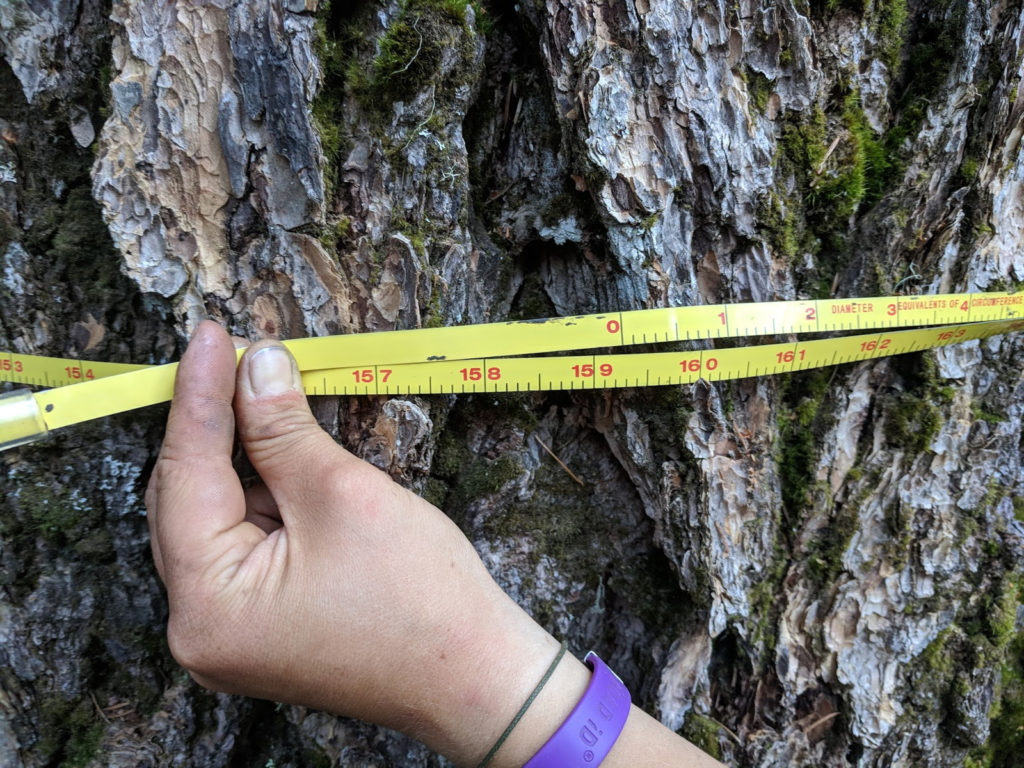
However, their work was to core, a job they were ambivalent about. They told me coring opened a gate for pathogens right at the root base, the start of the water column. I also heard that plenty of studies have shown the damage is minimal. This was especially true if considered against sawing the tree down. There was something sad when the coring hole seeped water; it was as if the tree were crying. Sometimes water fizzed around the bit. Once, tiny white insects fluttered out.
The work itself was hard. First, they bushwhacked in gear, bags heavy with borers of varying length and weight; water for a ten-hour shift; WD-40, a handsaw, bug spray, bear spray, a gun cleaning rod to unclog the tree borer, a long thin metal pole with a corkscrew at the end (also to unclog the borer), a trowel, sunscreen, first aid kits, a Garmin, smartphones, rangefinder binoculars, paracord rope, plastic straws for the samples, duct tape, yards of flagging, rain gear, and lunch.
After establishing a digital waypoint, someone stuck a trekking pole in the ground to mark the plot center. With emergency room-like efficiency, numbers and odd words were exchanged and noted. Katya started her visual survey. They would end up trampling the site, and she wanted to catalog the flora before it was indiscernible. One of the team members took the rangefinder to measure which trees fit in our plot. The rest tied powder-blue flags around small trees and orange flags around big ones. Then they cored. Because the forest could be as moist as parts of the coastal range (subject to heavy snowfall and marine air moving up the Columbia River) many of the rotten samples got jammed inside the bit, a hiccup that required a blend of patience, art, and muscle to repair.
They had golf tees donated from Jen’s husband to help unclog the bores. Because pressing metal to the bit was a surefire way to chip it, they used the wood or plastic tees. Another trick was jamming the spoon into the shaft while holding the shaft upside down. Another was a corkscrew or gun-cleaning rod. Barbecue skewers occasionally helped.
Some of the shafts were slightly bent. Laura told me to make it a priority to back them out, straight or not, relatively quickly. Trees could shift during boring. A shaft could get permanently stuck. For the really sunk ones you would tie p-cord to the handle, then around a nearby trunk. Each spin tightened the rope, reducing the need to pull. This method became a guilty pleasure because it allowed me to give my shoulder a break. Blisters had sprouted on the insides of my hands. A fire would spread from my forearms to between my shoulder blades and eventually up into my nape.
Flies on the mountain were braver than in the city. They shunned shooing as they traveled into various crevices and folds. Fat, pinching ants got inside sleeping bags. Jaunty mosquitoes were liberated in a place that was under snow 9 to 10 months out of the year. They dive-bombed, biting your forehead, earlobes, sides of the finger. I was covered in a film of bug spray, sunscreen and dust. Never in my life had a cleansing creek looked so inviting a place to dunk my head. The bees also reminded us whose habitat this was. Josefa was stung on the neck one afternoon, and the next took one in the palm after we accidentally kicked up a ground nest.
Often samples were crumbly with rot. Sometimes we tapped a “ghost tree,” where no sample came out at all. Or we pulled a sample that was not quite long enough, only a section of the tree ring eyeing the pith (there was no re-entering, you had to reverse out and bore in a new place). Once they got a passable sample, they measured the tree diameter at breast height (DBH). Laura’s advisor quipped that DBH happened at that height because foresters had been too lazy to bend all day. The crew broke twigs off in order to run a tape line around the tree. They then measured coring height, housed the sample in a plastic straw, which they sealed by melting the ends with a lighter.
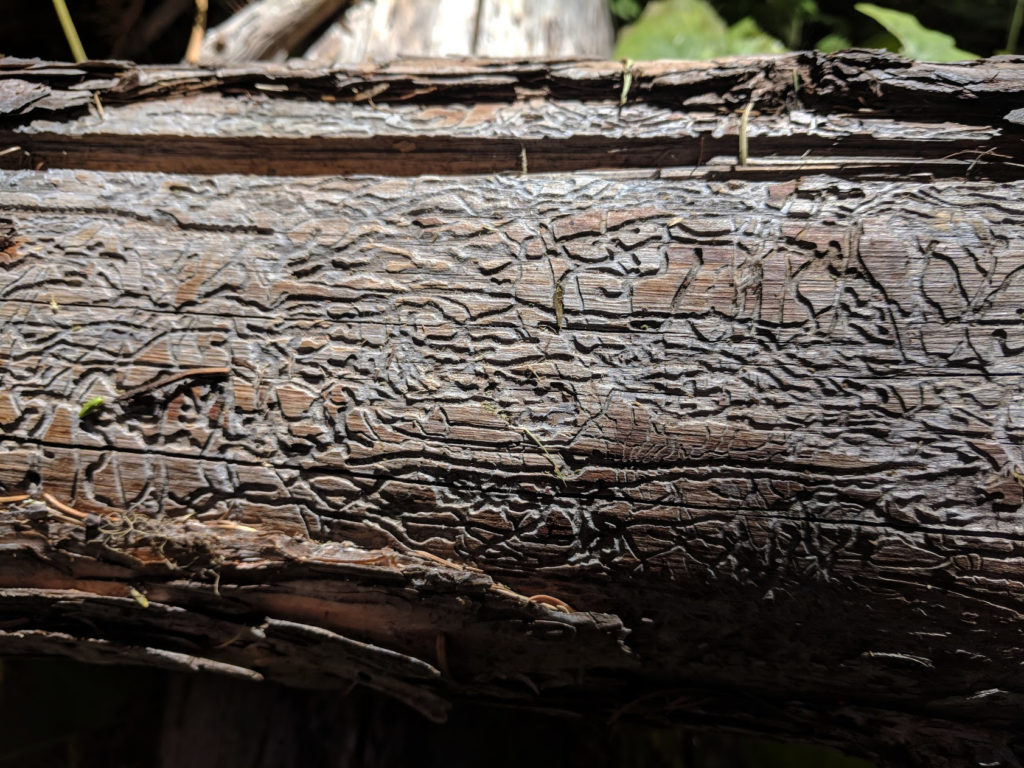
Hanging out with an all-woman work crew exposed interesting gender dynamics: the day laborers in Portland whistled at Laura and Jen in their truck. Katya’s fire crew boss told her to hit problematic men in the helmet with her shovel. She had, and it worked.
I caught new lingo. Ding-dong was a pronoun for almost anything:
“Pull the truck into that ding-dong.”
“Hand me that ding-dong over there.”
Creepy guys were considered “rapey.” Guys in the metal scene were especially problematic, they said, having consulted a secret website that allowed women to report sketchy men.
The earth mother stereotype came up. It goes something like this: because women are inherently nurturing, they are more in tune with the environment and thus better stewards of it. The history of environmental literature is full of language gendering nature as “she.” Screwing a piece of treated metal halfway into a 150 year-old fir could be seen as subverting this narrative.
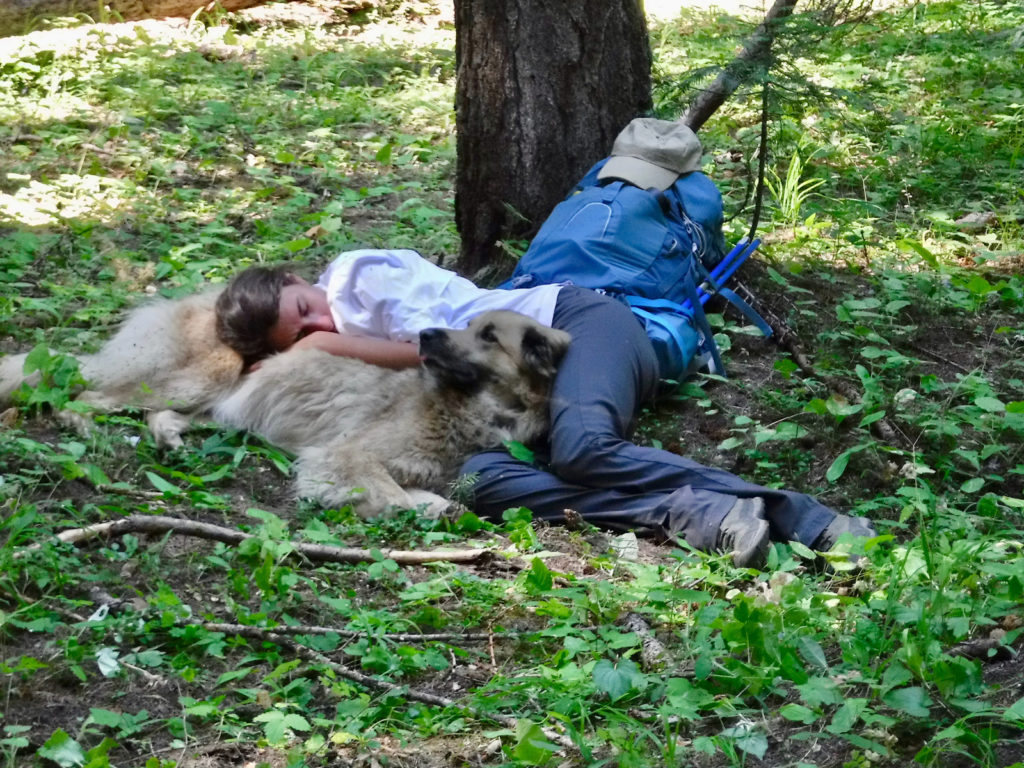
Regardless, the crew helped me see a side of the woods that had been invisible to me. They pointed out how the furrows in Douglas fir bark were deeper and easier to follow up than a grand fir; the ponderosa coat was red and puzzle-pieced; the bark of the spruce thin and scaly. Staring at trees tuned in other senses. I began putting bark, lichen, and leaves up to my nose or into my mouth. I began to notice the dawn music of squirrel chatter and birdsong. I heard the crash long before I saw the heads of three elk nodding uphill.
We drove home through a haze of smoke blown in from southern Oregon wildfires. A brownish cloud hung over the city of Pendleton. Further west, wind turbines spun above charred hillsides. A road crew reinforced a concrete barrier under a slope of blackened trees in Eagle Creek.
Fire has always been an ecological necessity, but climate change-induced megafires were scrambling the board. In an effort to better see history and hone more accurate predictions, scientists drilled deep in the woods. The time tubes they extracted got sanded and glued to a piece of balsa wood in a lab. Their data were helping answer a complicated question: how should an at-risk forest be managed in the coming years?
Those wanting answers included tribal groups, a timber company, environmentalists, and recreationalists. Forest ecologists promoted adaptive learning models. To some extent, we have to be open to figuring it out as we go—managing resources was inherently flawed, they argue; nature cannot be bossed. In his recent essay on western wildfires and climate change, Richard Manning writes, “Wilderness has no reasoning, no wishes, no preferences. Instead it deploys death and fire to prepare the way for whatever is to come.” Paul Hessburg echoes this. The question for the public is not whether there will be fire or smoke, he says, “but how they might want their fire and smoke.”
The forest, meanwhile, buzzed in the morning and creaked in the wind at night.
Paul Lask teaches writing at Portland State University, where he’s a faculty fellow with the Institute for Sustainable Solutions. He has published work in Willamette Week, Travel Oregon, and Fail Better magazine.
Photo credits: Laura taking a core sample, group shot of the work crew, and Josefa sleeping by Paul Lask. All other photos are by Katya Davidson.
If you value great writing like this on issues that matter in the Pacific Northwest, please consider becoming a supporting reader of Cascadia Magazine. We rely upon the generous financial support of readers like you to pay our writers and photographers a fair wage for their work. To make a contribution, please visit our donate page.
And if you’re already a supporting reader, thank you!
